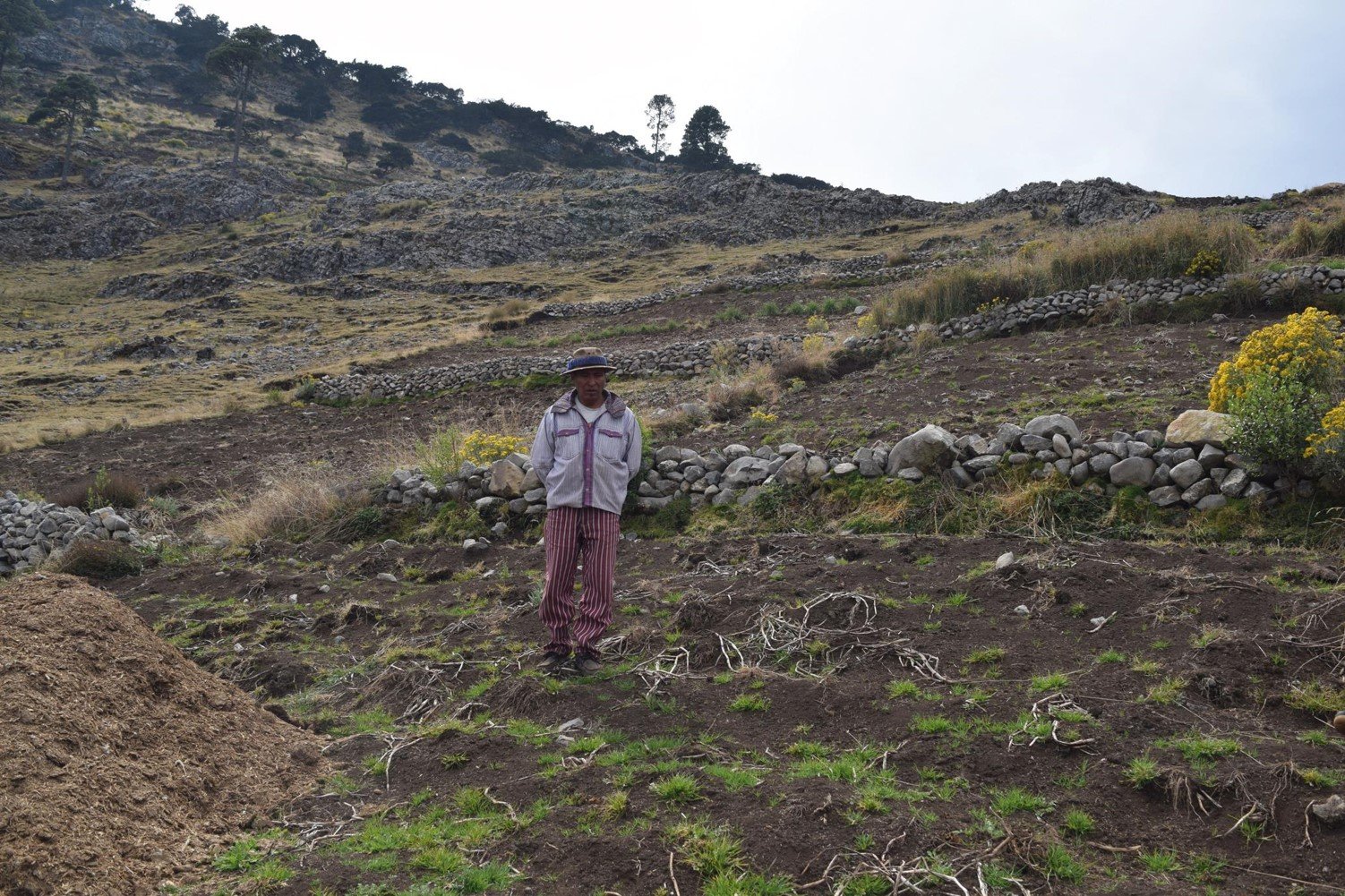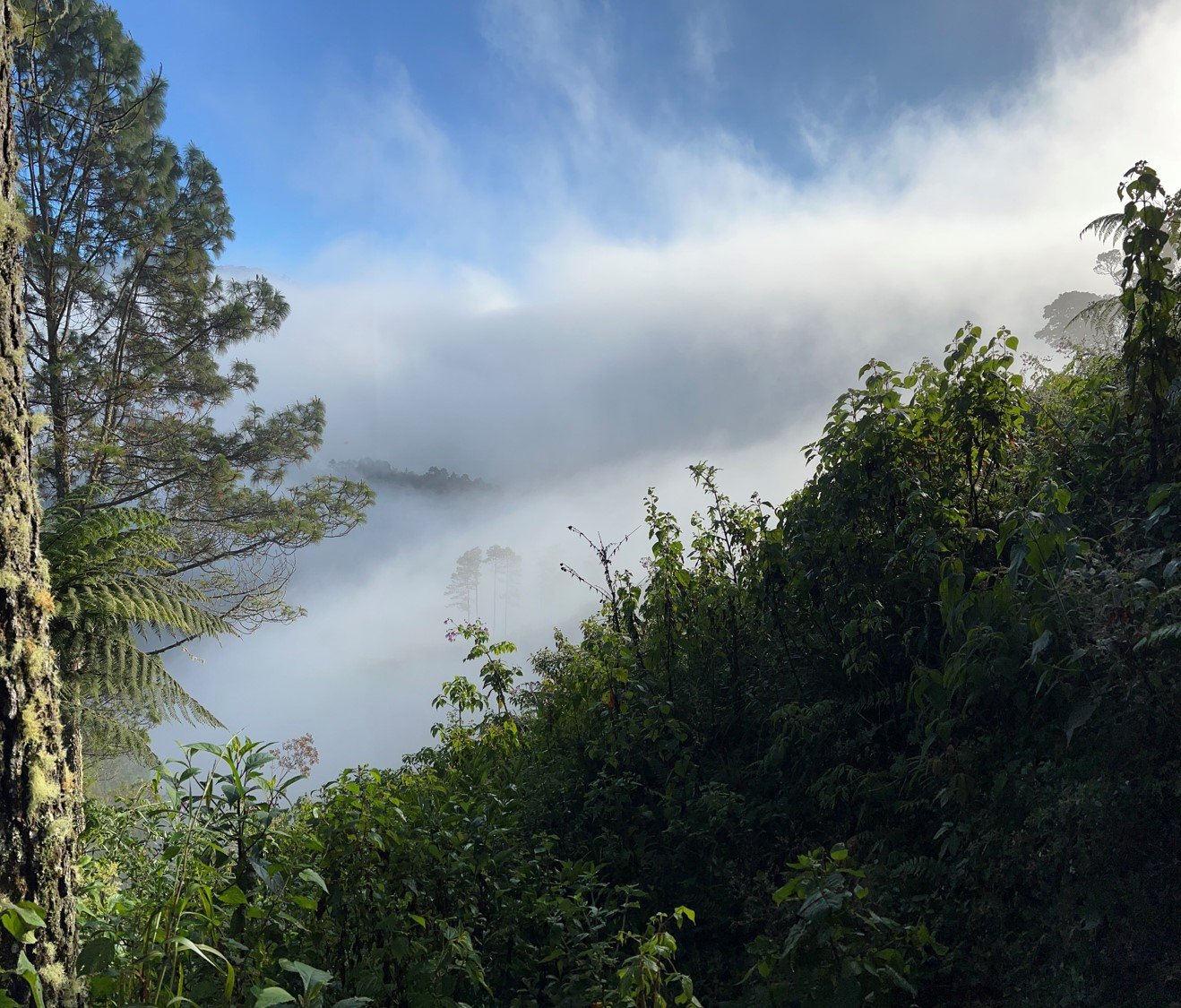The Good Works of
Community Cloud Forest Conservation
A nonprofit working in the
Mayan Highlands of Guatemala
Community Cloud Forest Conservation begins with the word “Community.”
The Cloud Forests of the Central Mayan Highlands cover only the highest ridgetops where they exist as ever-shrinking forest islands. Each year industrious families apply slash-and-burn techniques to expand their fields higher and higher toward the ridgetops to grow a bit more corn, burning more and more of the old-growth forest with each passing year. The higher the farmers press their way up the mountainsides, the colder the temperatures, the steeper the slopes, and the poorer their yields. Sometimes when men are planting the corn, they have to tie ropes around their waists so they don’t fall off the mountainsides. Rural families in Guatemala tend to have large families. A growing population means, of course, that more and more land is needed for corn - the staple grain of the Mayans - even when the required input of energy to grow that corn outstrips its return. In its early days of its inception, CCFC saw clearly that to protect the Cloud Forests, the core of their work would be working closely with the people.
Scroll below the photo gallery for more information on CCFC’s good work.
















The CCFC story began in 2001, when its founders, Rob & Tara Cahill, arrived in Guatemala with the funding to help establish agro-ecology education in the Central Mayan Highlands. They fell in love with the Cloud Forest and soon recognized the only way to save it was to educate the young people in the villages that bordered those forests. They observed that only half of female children entered school and of the ones who did, almost none of them graduated. Tob and Tara also recognized that if they were going to serve the well-being of the local communities as well as the Cloud Forest, the young girls would need special attention. Most rural female students drop out as soon as they become pregnant, which is often around the age of 14, and then bear children for the next twenty years or more of their lives. Tragically, large families cement the inescapable poverty of Guatemala’s rural Mayan households. Fortunately, these population trends are changing across Guatemala, but not nearly fast enough.
With a special focus on women. Rob and Tara knew the best environment to promote family planning was to enroll young girls in school, and then find a way to keep them there - convincing the girls and their parents that schooling provided tangible benefits. Rob and Tara’s first school for teenage girls debuted in 2008 as a day course. and was attended by seven ladies. Two years later, Community Cloud Forest Conservation (CCFC) was born - a twin nonprofit with one organization in the States, and one in Guatemala.
“Kids and Birds” takes off. In 2011 CCFC received a grant from the US Fish and Wildlife Service to develop a curriculum for a residential Kids and Birds program that would teach pre-teen boys and girls about the world-significant birdlife inhabiting the dwindling cloud forests. The 2-year pilot program was launched in 2013 with further funding assistance from Cornell University. Kids and Birds proved to be so successful that when the grants ran out, CCFC managed to keep the program going with donations from individuals and colleges. They also supplemented their nonprofit’s income by hosting groups of visitors from the United States and Europe - all of whom were eager to learn about the Cloud Forest and CCFC’s innovative education program. CCFC was now in an era of rapid growth, and residential dormitories were constructed to support the Kids & Birds program.
WALC - a special program for young teenage women. In 2014 the WALC program was launched (Women in Agroecology Leadership for Conservation). Each WALC residential school is 25 days long and is taught in the local language by previous graduates of the program - woman to woman. An average of 155 young ladies enroll in the brilliantly designed program. The goal is not to put a band-aid on family challenges associated with poverty, but offer real solutions. Food scarcity is diminished by teaching the young women the principles of agroforestry - reviving ancient Mayan knowledge on how to grow greens and high-protein legacy plants under a forest canopy. Family planning empowers women to voluntarily make conscious family-centered decisions that reduce family size. Classes on health care effectively reduce child and mother mortality with surprisingly simple tools. Bird ecology lessons reinforce pride in the students’ homeland and the importance of the cloud forest in providing clean water and supporting a complex and beautiful natural community. Reforestation and tree propagation teach stewardship skills that reduce deforestation, showing the young women that the steep mountain highlands rising above them have purposes beyond simply serving as marginal corn fields.
Keeing Girls in School. A $175 stipend is provided to every WALC student upon graduation - enough money to enable a young woman to stay in school. And it works. When families have to choose among their offspring who they can afford to send to school, boys are usually prioritized over girls. When the girls, however, can earn enough income to pay their way, and when they express their desire to stay in school, most families will honor their wishes.
Reforestation in action. CCFC’s mission to preserve the Cloud Forest is further advanced by requiring each WALC student to take a portion of their family’s croplands out of corn production and plant the parcel of land with native cloud forest trees, propagated with their own hands on the campus grounds. Around these tree plantings, WALC students plant traditional Mayan shade-grown crops that will support their extended family with nutritional foods for decades. Each student documents with photos that the requirement has been met.
Finally, given that the low life expectancy of women is largely due to mothers breathing in the smoke from unvented indoor cooking fires, the young women teaching the WALC program to the next generation of girls are given the option of either getting paid for their teaching services or, in lieu of payment, earning an elegantly designed wood cookstove equipped with an outside smoke vent that CCFC orders in bulk at very reasonable prices. Many teachers choose this option and are able to present stoves to their mothers at the end of the school year. This is truly a gift of love because such stoves measurably extend their mothers’ lives. Check out this great video.
When Arc of Appalachia representatives visited CCFC and met the teachers preparing for the coming year of classes, we found it telling that every teacher we met was currently in college, learning to be a teacher, nurse, attorney, or other professional position in their society. When a woman can make a gainful living in the community and landscape she loves, she won’t become a tragic statistic on the American border. This is problem-solving at its most basic level, and compassion in action.
CCFC has come a long way since 2014. Today Kids & Birds runs five days a week, thirty weeks a year, and serves 40-50 students a session. Today CCFC boasts a 350-acre nature preserve on the lower elevations of the cloud forest, a stunningly beautiful residential campus that runs completely off the grid, and two large dormitories with dining halls and gathering spaces. CCFC’s program now serves 160 villages, teaches several hundred students annually, and provides one of the most effective education programs on the planet. CCFC is beloved throughout the far-flung corners of its service area, and that, we believe, is its truest sign of success.
Identifying core problems, and then actually solving them? Serving nature and people simultaneously? And now you know why those of us at the Arc think so highly of CCFC!! Please visit CCFC’s website, and consider sponsoring one or more WALC students through your inspired philanthropy.

